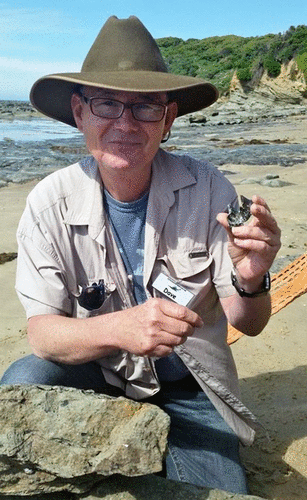Benjamin P. Kear [[email protected]] Museum of Evolution, Uppsala University, Norbyvägen 16, SE-752 36 Uppsala, Sweden.
THIS ISSUE of Alcheringa presents the first in a new series of invited special review articles that honour the distinguished Australian palaeontologist, geologist and malacologist Nell Ludbrook. Nell Ludbrook was a pioneering female scientist, and instrumental in forging much of Australia’s current Mesozoic and Cenozoic biostratigraphical framework.
The inaugural Nell Ludbrook Special Review (Poropat et al. Citation2018) has been contributed by a group of authors, with the seniormost being Thomas H. Rich and Patricia Vickers-Rich. Tom and Pat, as they are affectionately known within the Australian palaeontological community, are recognized internationally for their groundbreaking work (spanning over 40 years) on Early Cretaceous polar biotas from southern Victoria. These diverse faunas and floras are globally significant because of their association with cold palaeoclimates, and as a landmark source of discoveries elucidating the palaeobiology and palaeobiogeography of major vertebrate radiations, including dinosaurs and Mesozoic mammals.
Tom has been the Curator of Vertebrate Palaeontology at Museums Victoria since 1974, and Pat has served successively as a chaired Professor of Palaeontology at Monash University and Swinburne University of Technology in Melbourne. Together, Tom and Pat have authored over 25 books and some 300 research papers, with Pat also being awarded an Order of Australia in 2016 for her contributions to science.
The co-author team assembled by Tom and Pat for their Nell Ludbrook Special Review is led by Stephen Poropat, who is a specialist on Australian dinosaurs, and currently based at Swinburne University of Technology, with a joint appointment at the Australian Age of Dinosaurs Museum in Winton, Queensland. Sarah Martin from the Geological Survey of Western Australia is an Assistant Editor of Alcheringa, and works on Australian Mesozoic insects, as well as other fossil invertebrates. Anne-Marie Tosolini is a palaeobotanist, and Barbara Wagstaff is a palynologist, both of whom are based at the University of Melbourne and undertake research on Cretaceous southern polar floras and biostratigraphy. Lynne Bean is a retired teacher who actively publishes on Australian Mesozoic freshwater fishes. Lastly, Benjamin Kear from Uppsala University in Sweden is Chief Editor of Alcheringa and has a long history of researching Australian Mesozoic aquatic vertebrates.
The Nell Ludbrook Special Review by Poropat et al. (Citation2018) also carries a dedication to David (‘Dave’) Pickering (14.05.1950–24.12.2016). David devoted over 30 years of his life towards Australian palaeontology, most recently as Vertebrate Palaeontology Collection Manager at Museums Victoria. David was a skilful preparator and coordinator of field excavations. In particular, he maintained a longstanding interest in Plio–Pleistocene megafauna sites from western Victoria (Fig. ), with his numerous discoveries recognized by the naming of a new palorchestid, or ‘marsupial tapir’, Palorchestes pickeringi (Piper Citation2006). In addition, David’s contributions to research on Victorian Cretaceous fossils were recently honoured by the naming of a new ornithopod dinosaur, Diluvicursor pickeringi (Herne et al. Citation2018). Finally, David’s professionalism, personal integrity, enthusiasm and affable personality were attributes that made him a pleasure to work with. He will be sorely missed by all of his palaeontological friends, colleagues, students and museum volunteers alike.
References
- Herne, M.C., Tait, A.M., Weisbecker, V., Hall, M., Nair, J.P., Cleeland, M. & Salisbury, S.W., 2018. A new small-bodied ornithopod (Dinosauria, Ornithischia) from a deep, high-energy Early Cretaceous river of the Australian-Antarctic rift system. PeerJ 5, e4113.10.7717/peerj.4113
- Piper, K.J., 2006. A new species of Palorchestidae (Marsupialia) from the Pliocene and early Pleistocene of Victoria. Alcheringa 30 Supplement 1, 281–294.
- Poropat, S.F., Martin, S.K., Tosolini, A.-M.P., Wagstaff, B.E., Bean, L.B., Kear, B.P., Vickers-Rich, P. & Rich, T.H., 2018. Early Cretaceous polar biotas of Victoria, southeastern Australia—an overview of research to date. Alcheringa 42, 158–230.

